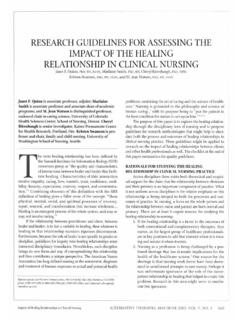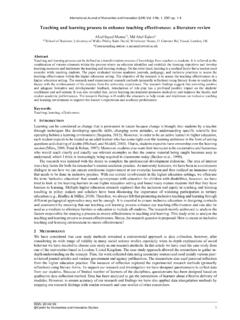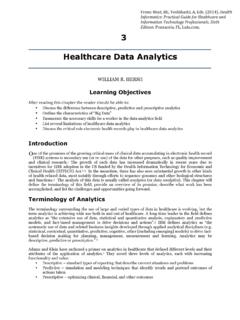Transcription of Chantal Cara, Ph.D., RN - Watson Caring Science Institute
1 A Pragmatic View of Jean Watson s Caring Theory Chantal Cara, , RN Universit de Montr al Faculty of Nursing Goals Provide an overview of Dr. Jean Watson s Caring theory to the nursing community. Facilitate the understanding of her work allowing nurses to readily apply this knowledge within their practice. Objectives Describe the general aspects of Watson s Caring theory. Describe how Watson s Caring theory can be applied to clinical practice. Describe the person through Watson s Caring lens. Describe the person s health through Watson s Caring lens.
2 Describe nursing through Watson s Caring lens. Key Words: Watson s Caring theory, clinical caritas processes, transpersonal Caring relationships, Caring occasion, clinical application of Watson s theory Abstract As most health care systems around the world are undergoing major administrative restructuring, we expose ourselves to the risk of dehumanizing patient care. If we are to consider Caring as the core of nursing, nurses will have to make a conscious effort to preserve human Caring within their clinical, administrative, educational, and/or research practice.
3 Caring must not be allowed to simply wither away from our heritage. To help preserve this heritage, Caring theories such as those from Jean Watson , Madeleine Leininger, Simone Roach, and Anne Boykin are vital. Through this continuing education paper we will learn the essential elements of Watson s Caring theory and explore an example of a clinical application of her work. Introduction The changes in the health care delivery systems around the world have intensified nurses responsibilities and workloads. Nurses must now deal with patients increased acuity and complexity in regard to their health care situation.
4 Despite such hardships, nurses must find ways to preserve their Caring practice and Jean Watson s Caring theory can be seen as indispensable to this goal. Through this pragmatic continuing education paper, we will explore the essential elements of Watson s Caring theory and, in a clinical application, illustrate how it can be applied in a practice setting. Being informed by Watson s Caring theory allows us to return to our deep professional roots and values; it represents the archetype of an ideal nurse. Caring endorses our professional identity within a context where humanistic values are constantly questioned and challenged (Duquette & Cara, 2000).
5 Upholding these Caring values in our daily practice helps transcend the nurse from a state where nursing is perceived as just a job, to that of a gratifying profession. Upholding Watson s Caring theory not only allows the nurse to practice the art of Caring , to provide compassion to ease patients and families suffering, and to promote their healing and dignity but it can also contribute to expand the nurse s own actualization. In fact, Watson is one of the few nursing theorists who consider not only the cared-for but also the caregiver. Promoting and applying these Caring values in our practice is not only essential to our own health, as nurses, but its significance is also fundamentally tributary to finding meaning in our work.
6 For a more comprehensive, philosophical, or conceptual perspective pertaining to Watson s Caring Theory, the readers can refer to the original work ( Watson , 1979, 1988a, 1988b, 1989, 1990a, 1990b, 1990c, 1990d, 1994, 1997a, 1997b, 1999, 2000, 2001, 2002a, 2002b, 2002c; Watson & Smith, 2002d), as well other sources, such as McGraw (2002). Overview of Watson s Caring Theory First, we begin with an introduction of Dr. Jean Watson . Dr. Watson is an American nursing scholar born in West Virginia and now living in Boulder, Colorado since 1962. From the University of Colorado, she earned her undergraduate degree in nursing and psychology, her master s degree in psychiatric-mental health nursing, and continued to earn her in educational psychology and counseling.
7 She is currently a Distinguished Professor of Nursing and the Murchinson-Scoville Chair in Caring Science at the University of Colorado, School of Nursing and is the founder of the Center for Human Caring in Colorado. Dr. Watson is a Fellow in the American Academy of Nursing and has received several national and international honors, and honorary doctoral degrees. She has published numerous works describing her philosophy and theory of human Caring , which are studied by nurses in various parts of the world. The following is a summary of the fundamentals of the Caring theory.
8 According to Watson (2001), the major elements of her theory are (a) the carative factors, (b) the transpersonal Caring relationship, and (c) the Caring occasion/ Caring moment. These elements are described below, and will be exemplified in the clinical application that follows. Additionally, the reader may consult Table 1 and Table 2 for the theoretical values and assumptions. Carative Factors Developed in 1979, and revised in 1985 and 1988b, Watson views the carative factors as a guide for the core of nursing. She uses the term carative to contrast with conventional medicine s curative factors.
9 Her carative factors attempt to honor the human dimensions of nursing s work and the inner life world and subjective experiences of the people we serve ( Watson , 1997b, p. 50). In all, the carative factors are comprised of 10 elements: Humanistic-altruistic system of value. Faith-Hope. Sensitivity to self and others. Helping-trusting, human care relationship. Expressing positive and negative feelings. Creative problem-solving Caring process. Transpersonal teaching-learning. Supportive, protective, and/or corrective mental, physical, societal, and spiritual environment.
10 Human needs assistance. Existential-phenomenological-spiritual forces. ( Watson , 1988b, p. 75) As she continued to evolve her theory, Watson introduced the concept of clinical caritas processes, which have now replaced her carative factors. The reader will be able to observe a greater spiritual dimension in these new processes. Watson (2001) explained that the word caritas originates from the Greek vocabulary, meaning to cherish and to give special loving attention. The following are Watson s (2001) translation of the carative factors into clinical caritas processes: Practice of loving kindness and equanimity within context of Caring consciousness.










